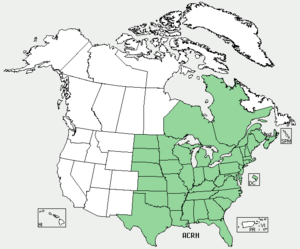Common three-seeded mercury facts for kids
Quick facts for kids Common three-seeded mercury |
|
|---|---|
 |
|
| Scientific classification | |
| Genus: |
Acalypha
|
| Species: |
rhomboidea
|
 |
|
| A. rhomboidea distribution | |
| Synonyms | |
The Common three-seeded mercury (scientific name: Acalypha rhomboidea) is a type of plant. It belongs to the spurge family, called Euphorbiaceae. Its name rhomboidea means "diamond-shaped." This describes the shape of its leaves. Other common names for this plant include rhombic three-seeded-mercury, rhomboid mercury, copperleaf, and rhombic copper-leaf.
Contents
What Does It Look Like?
Common three-seeded mercury is an annual herbaceous plant. This means it lives for only one year and has soft, green stems. It grows from a main root called a taproot. The plant usually reaches about 1/2 to 2 feet (15–61 cm) tall. Its main stem can be either smooth or covered with fine white hairs.
Leaves and Stems
The leaves are arranged alternately along the stem. They are shaped like a spearhead, sometimes a bit diamond-like, with pointed tips. The leaf stalks, called petioles, are slightly hairy and can be up to 1.5 inches (4 cm) long. The edges of the leaves have rounded teeth. The veins on the leaves are arranged like a feather. The top of the leaves is deep green and a bit shiny. The underside is light green and mostly smooth. Leaves can grow up to 2.75 inches (7 cm) long and 1.5 inches (4 cm) wide. Often, the leaves grow closer together near the top of the stem.
Flowers and Seeds
Where the leaf stalk meets the stem, there is a noticeable, slightly hairy, leaf-like part called a bract. This bract has 5 to 9 lobes (rounded sections). It wraps around the plant's flower cluster, which is called an inflorescence. The flowers themselves are tiny and green. They don't have petals.
The male flowers have four small, golden-green, upward-pointing parts called sepals. They also have many stamens, which are the male parts that produce pollen. The female flowers have tiny green sepals. They also have a hairy ovary with three sections and three fringed, thread-like parts called styles. Each section of the ovary produces one seed. When they are ready, the seed pods are tan-colored and about 1/15 inch (1.6-1.8 mm) long. They have deep lobes. These flowers do not have any scent.
Special Features
This plant is a bit unusual because it has clear sap. Most other plants in the spurge family have milky sap.
Common three-seeded mercury looks a lot like another plant called Acalypha virginica. You can tell them apart by looking at the bracts. Acalypha rhomboidea has 5-9 lobes on its bracts, while Acalypha virginica has 9-15 lobes. It also looks similar to young redroot pigweed (Amaranthus retroflexus L.). However, you can tell them apart by the way their flowers grow, their bracts, and sometimes the bronze-green color of the copperleaf's leaves.
Where Does It Grow?
Acalypha rhomboidea is native to parts of Eastern Canada and the Northeastern, Southeastern, and Central United States.
This plant often grows in rich, fertile soil. But it can also grow in rocky or clay soil. It prefers areas that have been disturbed by people or animals. You can find Common three-seeded mercury in many places. These include moist or moderately moist black soil prairies, open areas, or lightly shaded parts of forests. It also grows in thickets, wet spots, along riverbanks and lake shores, and on limestone glades and bluffs. You might also see it in fields, along fence rows, next to roads and railways, in empty lots, and in other waste areas.
Plant Life and Animals
This plant blooms from about mid-summer until the first frost in the fall. Its flowering period can last for a month or more.
The seeds of the Common three-seeded mercury are a good food source for birds. Birds like the mourning dove and greater prairie chicken enjoy eating them. Deer are also known to browse on plants from the Acalypha family.
Sometimes, this plant can become a problem in farm fields. This happens especially where certain chemicals, called herbicides, have been used many times.

